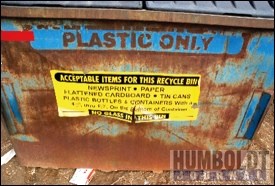Styrofoam is becoming a big problem in REACT's efforts to administer local recycling programs.
Despite not being a recyclable material, Styrofoam is popping up in nearly every recycling bin emptied by REACT. It's a major problem that was addressed at the company's annual general meeting, on April 16 in Humboldt.
"This is a chronic problem," said Wendy Yaworski, REACT's CEO. "Now that we're accepting plastics, people might think that Styrofoam is acceptable, but it's not."
Styrofoam - or polystyrene, its non-trademarked name - was invented by Dow Chemicals in 1938 and has been a staple of packaging ever since. As it is light, durable, water-proof and cheap, Styrofoam is a popular option for packagers, though its incredibly long lifespan makes it an environmental problem.
According to the U.S. Environmental Protection Agency, more than two-thirds of Styrofoam produced in the U.S. ends up in landfills, with much of that eventually finding its way into waterways.
Once in water, Styrofoam breaks down into a sort of soup-like substance that is harmful to plant and animal life. The problem is that recycling Styrofoam is both difficult and costly, meaning almost all recyclers aren't willing to take on the prohibitive cost.
In Humboldt, when the recycling is sorted, mounds of Styrofoam are removed, leading to extra costs for the program. Yaworski asked Humboldt city councillors who were in attendance at the REACT meeting to try and spread the word about removing Styrofoam from anything destined for recycling.
"We are asking people to remove any Styrofoam and flatten their boxes, because otherwise they take up so much bin space," Yaworski said.
Another key issue facing REACT is the ongoing search for a new site for the Humboldt landfill. The list has been narrowed down to a few quarters of potential land, though where exactly those quarters are won't be made public due to request of the landowners. Currently REACT is testing the land to ensure its suitability for a landfill site.
"We made one test hole down to about 450 feet," Yaworski said. "We've taken two other holes down to 30-45 metres to get a good understanding of whether the soil conditions meet the guidelines for a new landfill."
If any of the current proposed locations are approved, Yaworski expects that construction on the new landfill will begin next year.
As for the current landfill, which has been in use since 1976, REACT is in the process of filling the current available cells.
"There is between three and four feet of clay capping on cells that are full," Yaworski said. "The current cell we're on will probably last until the end of June."
Once the current landfill is no longer in use, it will begin a process of long-term decommissioning that could take more than a decade. At that point the site will need to be sloped and graded for proper drainage, then native plants and grasses will be planted to restore the area to a more natural state.
Work at the various REACT sites has also been slowed by the late-arriving spring and wet weather, pushing schedules back.
"We're hoping that it starts to warm up and dry out sooner rather than later," Yaworski said.
A final issue is the delayed implementation of an antifreeze collection program that was scheduled to start on April 1. The necessary equipment has not arrived, and so the collection process is delayed until that happens.
In the meantime, Yaworski and REACT are encouraging everyone to sort their recyclables and keep Styrofoam out of the bins.




